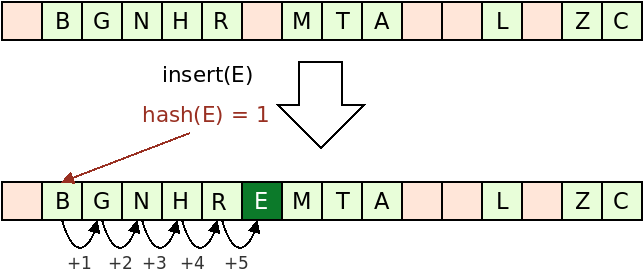 [AED069] Hash Tables with Open Addressing
[AED069] Hash Tables with Open AddressingIn what concerns the continuous evaluation solving exercises grade during the semester, you should submit until 23:59 of January 4th
(this exercise will still be available for submission after that deadline, but without couting towards your grade)
[to understand the context of this problem, you should read the class #11 exercise sheet]
 [AED069] Hash Tables with Open Addressing
[AED069] Hash Tables with Open AddressingIn this problem you should only submit a hashTableOA.h file with a self-containing definition of a class HashTableOA<KeyType>
Use as a basis the skeleton code of HashTableOA<KeyType> (see code | download code) which provides the initial code for a basic implementation of an hash table using open addressing with linear probing for collision resolution and lazy deletion.
Implement the following 3 methods (which already exist on the given file, but still lack functional code):
In all methods, to find the corresponding position (bucket) on the table, use modular hashing over the hash function of the class (that was initialized on the constructor), that is, for key k the position can be found calling hash(k) % size.
If the position is occupied, you should use linear probing, that is, go incrementally one by one over the positions (if necessary going back to the first bucket after the last bucket) until you find a bucket in the state you are looking for. A bucket can be in one of 3 states:
Deleted buckets are treated as empty when inserting (you can put a key there) and as occupied during a search for a key.
On methods insert and remove, don't forget to update the numberActive and numberDeleted variables to reflect the changes on the number of buckets that are active (contain a key) or deleted (contained a key, but was deleted).
You should submit the file hashTableOA.h with the methods contains, insert and remove implemented as requested (and without removing any of the other existing methods). You can however create additional methods, if you need them.
Mooshak will use the following code to link to your class, construct the hash table, read the operations and call your methods, printing its result.
#include <string> #include "hashTableOA.h" // Read hash table and then q operations template <typename KeyType> void read() { int n; std::cin >> n; std::hash<KeyType> h; HashTableOA<KeyType> hashTable(n, h); int q; std::cin >> q; for (int i=0; i<q; i++) { std::string op; KeyType k; std::cin >> op; if (op == "CONTAINS") { std::cin >> k; std::cout << "contains(" << k << "): " << hashTable.contains(k) << std::endl; } else if (op == "INSERT") { std::cin >> k; std::cout << "insert(" << k << "): " << hashTable.insert(k) << std::endl; } else if (op == "REMOVE") { std::cin >> k; std::cout << "remove(" << k << "): " << hashTable.remove(k) << std::endl; } else if (op == "SHOW") { std::cout << "showContents():" << std::endl; hashTable.showContents(); } } } int main() { std::string type; std::cin >> type; if (type == "int") read<int>(); else if (type == "string") read<std::string>(); return 0; }
| Example Input | Example Output |
int 5 17 INSERT 42 INSERT 39 SHOW INSERT 17 INSERT 12 INSERT 42 CONTAINS 17 CONTAINS 52 SHOW REMOVE 39 REMOVE 39 REMOVE 12 SHOW INSERT 10 INSERT 20 INSERT 52 SHOW |
insert(42): 1
insert(39): 1
showContents():
Size: 5 | Nr Active: 2 | Nr Deleted: 0 | Load Factor: 0.400
Table: {} {} 42 {} 39
insert(17): 1
insert(12): 1
insert(42): 0
contains(17): 1
contains(52): 0
showContents():
Size: 5 | Nr Active: 4 | Nr Deleted: 0 | Load Factor: 0.800
Table: 12 {} 42 17 39
remove(39): 1
remove(39): 0
remove(12): 1
showContents():
Size: 5 | Nr Active: 2 | Nr Deleted: 2 | Load Factor: 0.800
Table: DEL {} 42 17 DEL
insert(10): 1
insert(20): 0
insert(52): 1
showContents():
Size: 5 | Nr Active: 4 | Nr Deleted: 0 | Load Factor: 0.800
Table: 10 {} 42 17 52
|
Explanation of the Example Input:
On the "images", a red cell corresponds to an EMPTY bucket, a dark grey cell to a DELETED bucket and a green cell to an ACTIVE bucket.
An empty hash table is initially created with 5 buckets. Afterwards:
| 42 | 39 |
| 12 | 42 | 17 | 39 |
| DEL | 42 | 17 | DEL |
| 10 | 42 | 17 | 52 |